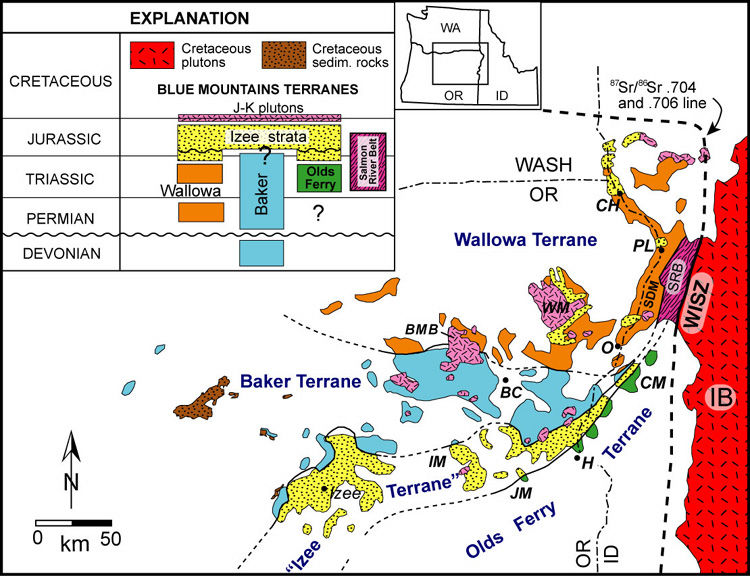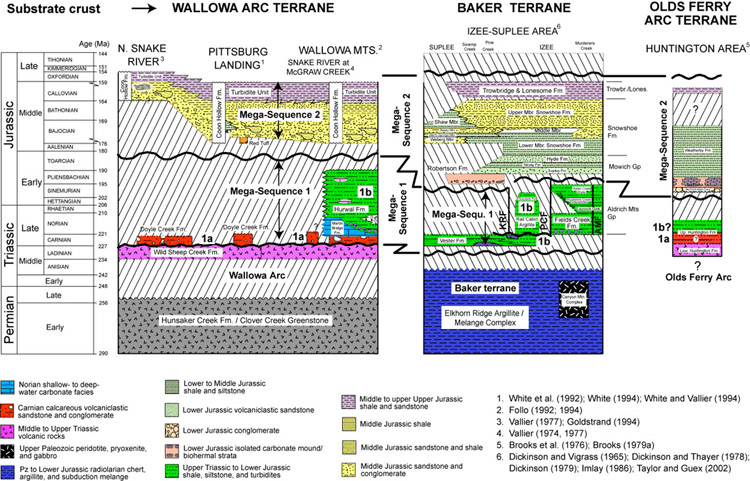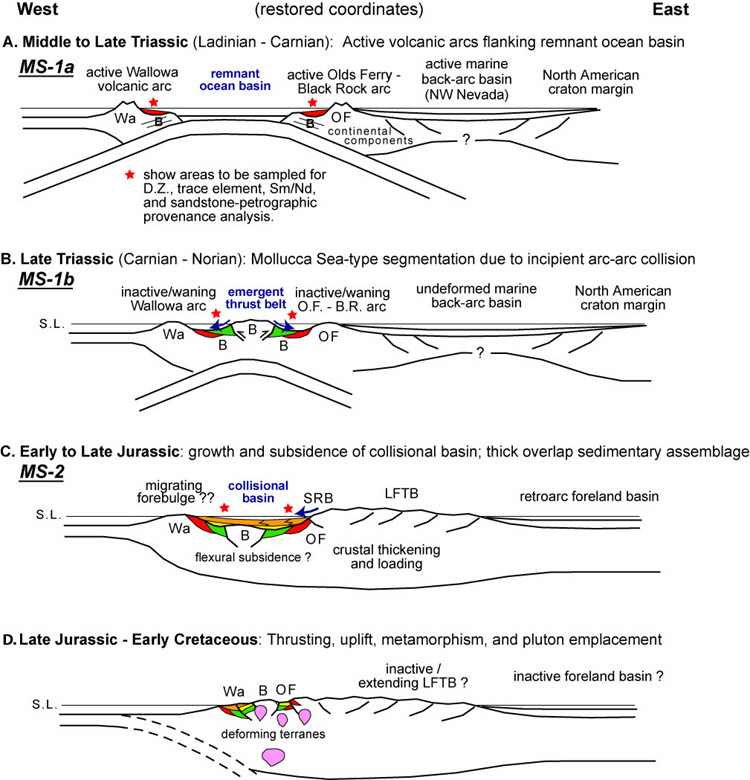Ongoing Research in the Blue Mountains, Northeastern Oregon
I'm conducting this NSF-funded study in collaboration with Jeff
Vervoort at Washington State University. This is the central topic of Todd
LaMaskin's PhD research, and he is taking the lead on many aspects of the
project. We are using a multidsicplinary approach to test a new hypothesis for
collisional tectonics and related basin development during Triassic and Jurassic
time in the Blue Mountains Province of northeastern Oregon. Our interdisciplinary
research combines detailed stratigraphy, field mapping, detrital zircon dating,
and trace-element and isotope geochemistry. With this data we hope to reconstruct
changes in basin geometry and provenance through time, and thus clarify the
major driving forces and plate interactions that controlled the tectonic evolution
of eastern Oregon and adjacent parts of the western U.S. Cordillera. The following
figures are from a paper that Todd and I recently submitted to AJS, which reviews
an extensive literature on the stratigraphy and tectonics of Mesozoic rocks
in the Blue Mountains, and presents a new hypothesis for Late Triassic arc-arc
collision followed by Jurassic arc-continent collision in eastern Oregon. We
are interested in how these events may be related to other parts of the western
U.S. and Canadian Cordillera, and their significance for understanding processes
of crustal accretion and continental growth. Our working hypothesis is just
the first step in this multi-year project. We have a series of tests lined up
and expect things will look fairly different by the time lots of new data come
in and get synthesized.

Figure 1. Generalized terrane map of the Blue Mountains Province (BMP), modified
from Dickinson (1979), Mann (1989), Follo (1992), Vallier (1995), Gray and Oldow
(2005). BC, Baker City; BMB, Bald Mt. batholith; H, Huntington; IB, Idaho Batholith;
IM, Ironside Mt.; JM, Juniper Mt.; O, Oxbow; PL, Pittsburg Landing; CM, Cuddy
Mt.; CH, Coon Hollow; SDM, Seven Devils Mts.; SRB, Salmon River Belt; WM, Wallowa
Mtns. (and batholith); WISZ, Western Idaho Shear Zone.

Figure 2. Chronostratigraphic correlation chart for sedimentary and volcanic
rocks in the Blue Mountains, compiled from multiple sources. The stratigraphy
provides a record of basin evolution, provenance, and controling tectpnic processes,
which we are investigating in this study. Our work would not be possible without
many pioneering studies by some great geologists, some of which are cited above,
that gave us our present knowledge of the geology and stratigraphy in the Blue
Mountains.

Figure 3. Schematic diagrams illustrating hypothesis for Late Triassic to Late
Jurassic arc-arc and arc-continent collision in the Blue Mountains Province
(BMP) and related collisional basin evolution. Restoration of ~400 km of post-Jurassic
dextral translation places the BMP outboard of the Black Rock (B.R.) arc and
LFTB in NW Nevada (Wyld and Wright, 2001). A. Pre-collisional
Wallowa (Wa) and Olds Ferry (OF) arcs; B. Doubly-vergent Molucca
Sea-type arc-arc collisional complex (B = Baker terrane) with coarse olistostromes
and gavel shed into flanking marine sub-basins (blue arrows); C.
Early to Late Jurassic growth of Izee collisional basin and onlap of sediments
onto older rocks and structures, deep subsidence possibly a flexural response
to thrust loading in LFTB; D. Thrusting, uplift, and post-kinematic
pluton emplacement related to initiation of new subduction zone. MS-1a, -1b,
-2 indicate mega-sequences.
Link to the webpage for our Blue
Mts Field Trip, March 24-29, 2007.
Blue
Mts Seminar, Fall quarter, 2006.
Dorsey and
LaMaskin (2006) and LaMaskin
and Dorsey (2006) Anchorage GSA abstracts.
Our thinking about collisional tectonics and related basin evolution is fleshed
out in a new "idea paper", which we submitted to AJS in November 2006.
Please contact me if you would like a copy.
The above material is based upon work supported by the National Science
Foundation (Grant No. EAR-0537691). Any opinions, findings or conclusions expressed
herein are those of the authors and do not necessarily reflect the views of
the National Science Foundation (NSF).
Return to Dorsey's Homepage
This page was last updated March 2007, by Becky
Dorsey.


